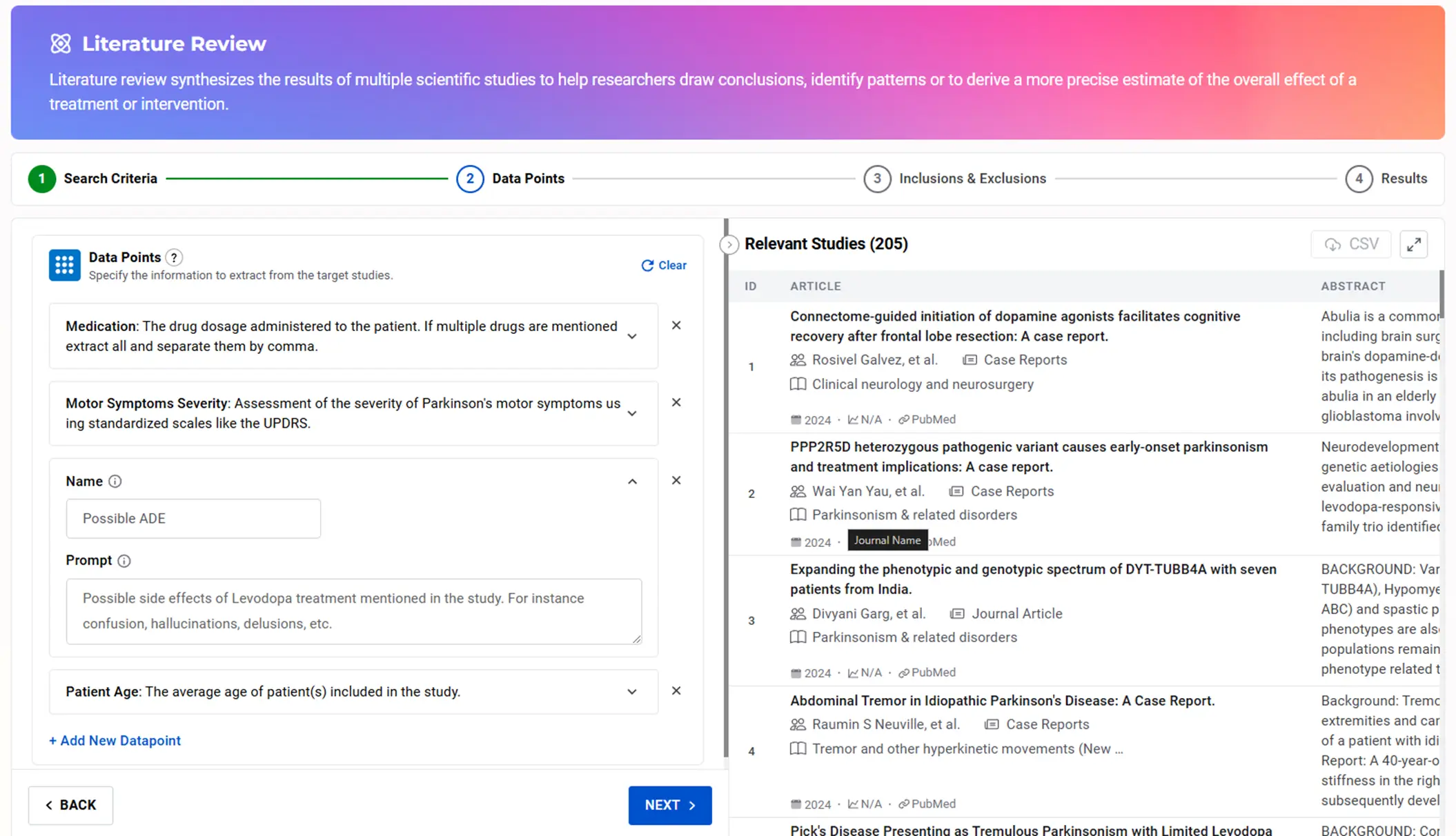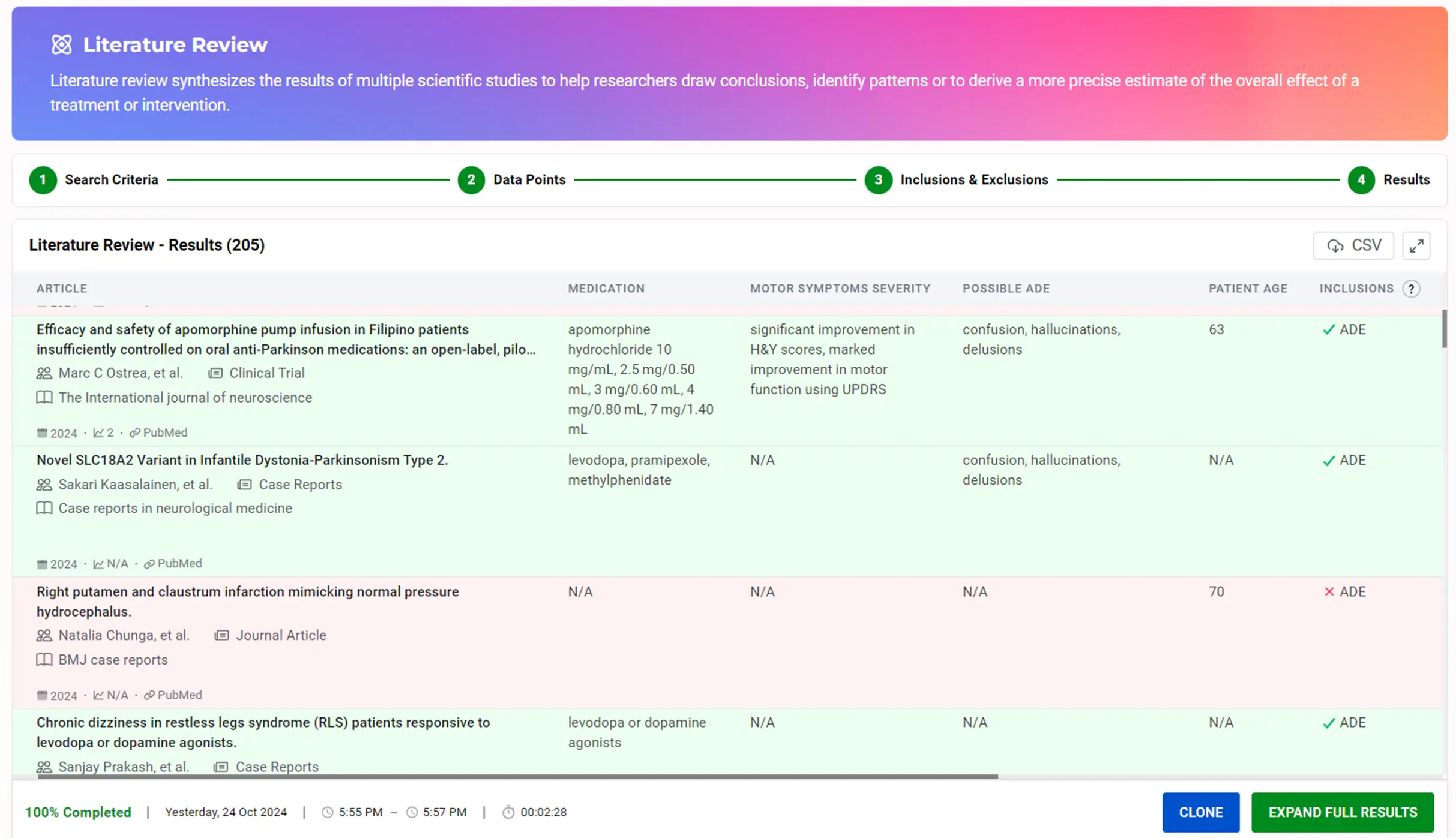Navigating the world of medical research often feels like diving into an ocean of information without a map. For researchers, healthcare professionals, and clinicians, effectively conducting literature reviews is critical but inherently complex and time-consuming. To meet this challenge, we are thrilled to introduce the Literature Review feature in the Medical Chatbot—a new AI-powered tool designed specifically to make medical literature research and review easier, faster, and more accurate.
The literature review process involves searching, reading, analyzing, and synthesizing scholarly articles on a given topic to map out existing knowledge and identify gaps. Traditionally, this is an exhaustive process, requiring specialized skills to ensure sensitivity and specificity in search results. Even experienced research teams can find themselves overwhelmed. Enter the Literature Review feature, a powerful solution for smarter literature navigation, empowering researchers with efficiency and precision.
What is the Literature Review For?
The Literature Review is a new feature offered by the Medical Chatbot, implemented as an advanced AI agent that allows you to intelligently search through millions of research papers and articles from trusted sources such as PubMed, BioRxiv, and MedRxiv. It offers the capability to quickly identify relevant studies, extract key data, and even apply customizable inclusion and exclusion criteria—all within a seamless, interactive interface.
With features like automated data extraction, real-time filtering, and intelligent tabular result views, users can focus more on synthesis and analysis rather than tedious manual searches. Here are the key highlights:
Key Features
1. Intelligent Search and Data Filtering for Precise Targeting
With simple keywords, effortlessly search through vast repositories of medical literature. Start by defining your search parameters using keywords related to your topic of interest. You can further refine these searches with customizable filters such as publication dates, impact factors, and study types. These filters allow you to achieve a granular level of control over the studies included, ensuring that the results are highly relevant.
Advanced Search with Logical Operators
Now you can use AND, OR, and NOT operators to create nuanced search queries—excluding or combining topics based on your needs. Start by defining your search parameters with specific keywords relevant to your research goals. You can further refine your search using logical operators to combine or exclude specific criteria, such as ‘cardiovascular disease AND exercise’ but ‘NOT medication’. These combinations help you create targeted and complex searches that ensure only relevant studies are retrieved.

Visualization of Query Structure
The interface visually displays search terms and their logical relationships, making it easier to adjust and understand how each keyword and operator (OR/AND/NOT) affects search outcomes. This visual representation makes it easier for users to adjust search terms and immediately see their impact, enhancing the clarity and efficiency of the search process.

Furthermore, users can now specify the fields they want to target with the defined search keys, including Study Title, Text Content, and Journal Name. This makes it easier to focus on particular aspects of studies, ensuring search results align more closely with user research objectives, and reducing the time needed to filter irrelevant content.
Filters to Refine the Search Results
Filters are also available to refine the search results according to user preferences. Currently, users can leverage filters such as publication date, journal impact factor, and study type to further tailor their search. As users enter their search or filter criteria, the chatbot displays relevant literature in real-time. This immediate feedback allows users to open and review papers right away, without having to wait for the entire review process to complete. By streamlining the search process, this feature facilitates faster access to relevant information, saving users time and effort.

Real-Time Feedback
The chatbot continuously refines results as you enter search criteria, enabling immediate access to the most pertinent information. As you input or modify target KBs, keywords, or filters, the chatbot dynamically adjusts the search results and provides instant feedback on the impact of these changes. This means that if you narrow down your criteria—such as specifying a more recent publication date or adding an additional keyword—you will see the search results update in real time. This feature allows you to iteratively refine your review, ensuring that the information you gather is both relevant and up-to-date without the need to restart the search. For example, if you decide to exclude Case Reports, the results will be instantly updated to reflect that change, saving you valuable time and providing clarity throughout the review process.
2. Smart Data Extraction
Define the data point name you need in plain English, such as ‘sample size,’ ‘primary outcome,’ or ‘adverse event.’ For each data point, you can provide a custom prompt to help the LLM better understand the specific concept that needs to be extracted. For instance, to define ‘sample size,’ you could use a prompt like: “Identify the number of participants involved in the study, including control and experimental groups.” You can also provide examples, such as “e.g., 200 patients: 50 in the control group, 150 in the treatment group.”

The chatbot will intelligently analyze the filtered literature to locate and extract these defined data points, significantly reducing the time required for data extraction and minimizing the risk of missing critical information. Each value extracted is also backed by evidence, stored alongside the value for the data point to support its accuracy.

Users can hover over individual data cells in the results table to see tooltips containing evidence or explanations for the extracted data. This feature provides quick access to deeper insights without cluttering the main view, enabling users to better understand and verify the extracted information efficiently.
3. Customizable Inclusion/Exclusion Criteria
Tailor your review by defining specific inclusion and exclusion criteria. For each criterion, you can specify a name and a prompt definition to give the LLM a better understanding of the conditions that need to be met by the studies.
For instance, if your study focuses on specific geographic locations, you could define an inclusion criterion like ‘North America’ with a prompt such as: “Include only studies conducted within the regions of North America.” On the other side, if you are looking for studies with concrete in-vivo results obtained on human patients, you could define exclusion criteria such as ‘Animal Models’, with the prompt: ‘Studies reporting results on animals instead of human patients.’
Whether focusing on study populations, methodologies, intervention types, or specific outcomes, these prompt definitions ensure that the LLM identifies studies that are most relevant to your research needs. The chatbot will automatically verify compliance with these criteria and indicate which studies meet or fail the conditions, providing a color-coded summary to streamline your review process. This feature ensures your review is highly targeted, relevant, and aligned with your research objectives.

There is no one-size-fits-all solution for defining prompts for data points or inclusion/exclusion criteria. The process often requires experimentation, as the effectiveness of prompts can vary depending on the context of your research. A practical approach is to create multiple versions of a review by cloning it and experimenting with different prompt formulations. By doing this, you can assess which prompts yield the most accurate and relevant information. Iteratively refining these prompts allows you to better align the Literature Review’s outputs with your specific research objectives, thereby enhancing both the relevance and the quality of the extracted data. This iterative experimentation is crucial in ensuring that your criteria effectively capture the nuances of your study.
4. Comprehensive Result View
View relevant studies in an intelligent tabular format—including title, author, journal, and key data points, alongside compliance with defined inclusion/exclusion criteria. Each row in the table provides a structured overview of key information, allowing you to quickly assess the relevance of each study. The tooltips offer deeper insights without cluttering the main view, providing detailed explanations or additional data when you hover over specific cells. For example, hovering over the age exclusion criteria in the example below reveals a brief summary of the results, such as ‘The patient was 89 years old, which is above 60 years old‘. This organized, dynamic table ensures that users can efficiently manage and interpret the wealth of information extracted from each study.

To provide greater transparency, the chatbot offers time-based metrics throughout the Literature Review process, including Queue Time, Progress Time, and Completion Stats. These metrics offer insights into each stage of the review process, enabling users to better manage their workflow and set realistic expectations.

These metrics provide users with key insights, including:
- Queue Time: The time the review spends in queue (e.g., “In queue for less than a minute”).
- Progress Time: The duration the review has been running (e.g., “Running for 3 minutes”).
- Completion Stats: Once the review is complete, users can view the Completion Date, Start Time, End Time, and Total Time Taken for the entire process.
5. Downloadable CSV Reports
Download your review results and extracted data into a well-organized CSV file for further analysis and collaboration with your research team. The CSV report includes key data points such as study titles, authors, publication dates, extracted data points, compliance with inclusion/exclusion criteria as well as evidence on all extractions. This format allows users to easily import the data into tools like Excel or statistical software for deeper analysis. You can also share the CSV files with your colleagues, making it simple to collaborate on data interpretation and streamline the communication process within your research team. For example, if your team is working on a meta-analysis, the extracted data can be used directly for statistical modeling or other advanced analyses.
6. Cloning Literature Reviews
Save time by cloning completed reviews. You can replicate search settings, data points, and filters for new reviews with just one click, enabling a streamlined process for similar research projects. This feature is especially beneficial for conducting repeated runs, which are often necessary for refining experiments or incorporating newly published research. For example, if you need to update your literature review every few months to include the latest studies, cloning allows you to replicate your initial setup and quickly adjust it to include new data, ensuring that your research remains current. This ability to efficiently replicate and adapt reviews is crucial for iterative research processes, where experiments must be validated, refined, or extended over time.
These features enable you to complete comprehensive literature reviews in minutes—instead of spending weeks or months on manual reading and analysis.
User Benefits
Significant Time Savings – The Literature Review feature significantly reduces the manual effort typically required, allowing researchers to focus on deeper analysis rather than data gathering. Comprehensive reviews that once took weeks can now be completed in a fraction of the time.
Specificity – With targeted data points extraction and inclusion and exclusion criteria enforcement, the tool helps ensure that your literature review is robust and focused, yielding more precise and trustworthy results.
Enhanced Clinical Decision-Making – With accurate, real-time access to relevant studies, the Literature Review feature directly supports clinicians in making informed, evidence-based decisions—vital for patient outcomes and healthcare quality.
Get Started
The Literature Review feature in the Medical Chatbot is a game-changer for anyone involved in medical research—from clinical practitioners to academic researchers. It provides a powerful combination of automated data extraction, customizable search criteria, and real-time results, all designed to help users perform literature reviews faster and more accurately than ever before.
We invite you to try the new Literature Review tool and experience firsthand how these cutting-edge features can transform the way you conduct medical research. Whether it’s for clinical decision-making, meta-analyses, or evidence-based practice, this tool is designed to save you time, enhance your focus, and elevate your work.
Ready to accelerate your research? Sign up for the Medical Chatbot and start exploring the Literature Review feature today with your free 7-day trial. Let the Medical Chatbot bring clarity and efficiency to your medical research journey.





























